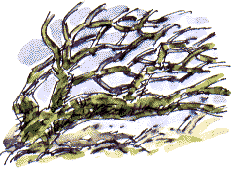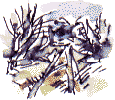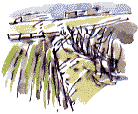 A MOSS-COVERED ELDER, which wouldn't look out of place in the mysterious Wistman's Wood on Dartmoor, gives a hint of the anitiquity of this little used green lane, not far east of the Ossett junction of the M1 motorway.
A MOSS-COVERED ELDER, which wouldn't look out of place in the mysterious Wistman's Wood on Dartmoor, gives a hint of the anitiquity of this little used green lane, not far east of the Ossett junction of the M1 motorway. The first Ordnance Survey map of 1841 shows the lane climbing to the Wakefield to Dewsbury turnpike road. This turnpike was surveyed in part by Blind Jack of Knaresborough and here follows the line of the Doncaster, via Wakefield, to Manchester Roman road. On the 1841 map the hill is called Mount Pleasant, surely by this time something of a euphamism as it was surrounded by coal pits and a sandstone quarry with Mr Smithson's colliery tram road (still worked by oxen at that time, I believe) in the valley below. Later maps show the arrival of the Ossett branch of the Great Northern Railway, the name Mount Pleasant has been dropped but adjacent Shepherd Hill, a little to the west, is named.
The first Ordnance Survey map of 1841 shows the lane climbing to the Wakefield to Dewsbury turnpike road. This turnpike was surveyed in part by Blind Jack of Knaresborough and here follows the line of the Doncaster, via Wakefield, to Manchester Roman road. On the 1841 map the hill is called Mount Pleasant, surely by this time something of a euphamism as it was surrounded by coal pits and a sandstone quarry with Mr Smithson's colliery tram road (still worked by oxen at that time, I believe) in the valley below. Later maps show the arrival of the Ossett branch of the Great Northern Railway, the name Mount Pleasant has been dropped but adjacent Shepherd Hill, a little to the west, is named. The railway was axed in the 1960s and today the noisy motorway dominates an area that was, for a while, after the closure of the coal pits, a little visited blind valley. It appears to me that one footpath truncated by the motorway follows the ditch and embankment boundary of the medieval deer park, called the New Park since Norman times to distinguish it from the Old Park on the other side of Wakefield. Place names like Paleside and Lodge Hill are reminders of this Park.
The railway was axed in the 1960s and today the noisy motorway dominates an area that was, for a while, after the closure of the coal pits, a little visited blind valley. It appears to me that one footpath truncated by the motorway follows the ditch and embankment boundary of the medieval deer park, called the New Park since Norman times to distinguish it from the Old Park on the other side of Wakefield. Place names like Paleside and Lodge Hill are reminders of this Park. Hunting parks were run for profit rather than pleasure. In medieval times, while the lord of the manor was away keeping the Scots raiders at bay, large gangs of armed men would descend on the parks and help themselves to huge quantities of meat on the hoof. One account mentions 200 swans being taken. Imagine it; 200 swans in a park near Wakefield! - it must have resembled the famous Abbotsbury Swanery in Dorset.
Hunting parks were run for profit rather than pleasure. In medieval times, while the lord of the manor was away keeping the Scots raiders at bay, large gangs of armed men would descend on the parks and help themselves to huge quantities of meat on the hoof. One account mentions 200 swans being taken. Imagine it; 200 swans in a park near Wakefield! - it must have resembled the famous Abbotsbury Swanery in Dorset. The western end of this area is scheduled for a massive strip mine, 200 metres deep, which will effectively sterilise the landscape of such scruffy remnants of its former history. Of course you can't keep everything and most people today are scarsely aware of the history under their feet anyway, and if they were they wouldn't care about it. But what of future generations? They might be interested and they might have more refined ways to investigate the past. Who knows what we might have swept away by then?
The western end of this area is scheduled for a massive strip mine, 200 metres deep, which will effectively sterilise the landscape of such scruffy remnants of its former history. Of course you can't keep everything and most people today are scarsely aware of the history under their feet anyway, and if they were they wouldn't care about it. But what of future generations? They might be interested and they might have more refined ways to investigate the past. Who knows what we might have swept away by then?Richard Bell,
wildlife illustrator
E-mail;'richard@daelnet.co.uk'